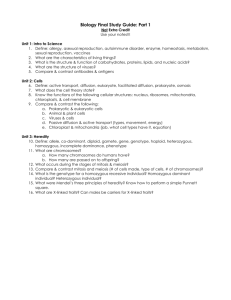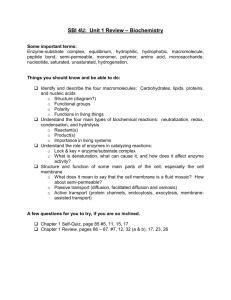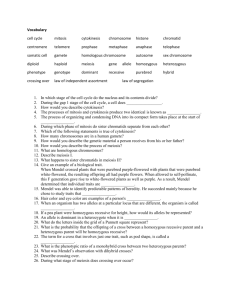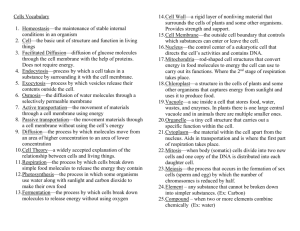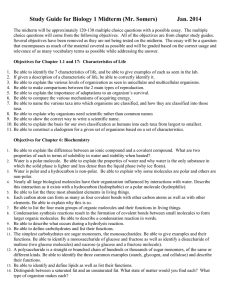Study Guide - Tacoma Community College
advertisement
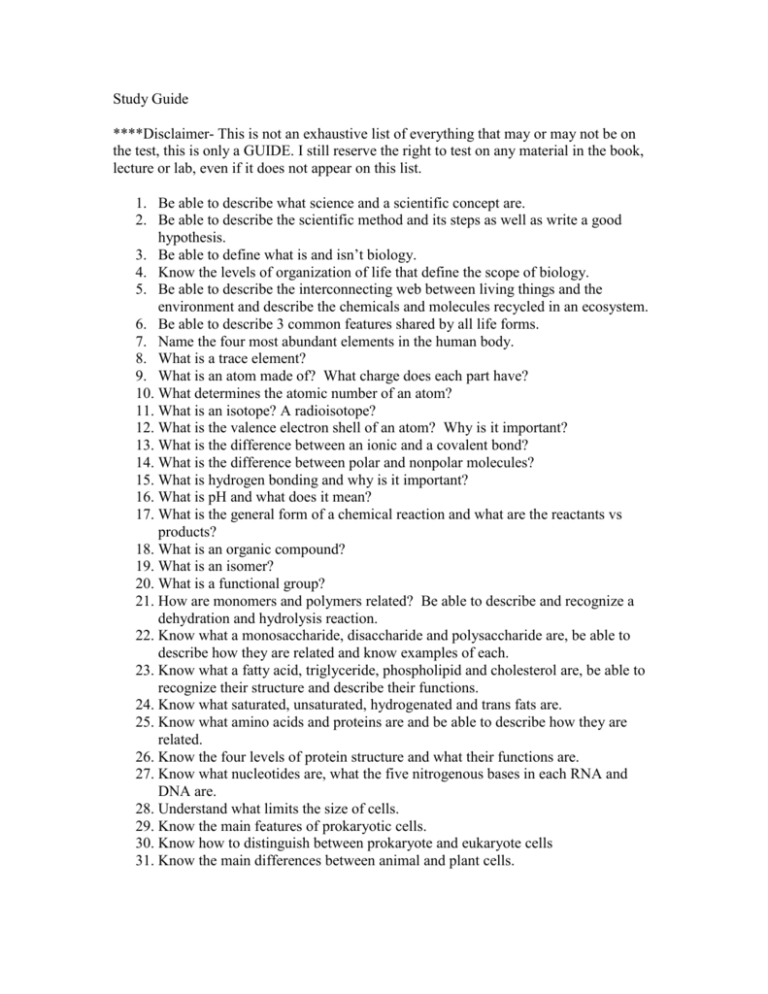
Study Guide ****Disclaimer- This is not an exhaustive list of everything that may or may not be on the test, this is only a GUIDE. I still reserve the right to test on any material in the book, lecture or lab, even if it does not appear on this list. 1. Be able to describe what science and a scientific concept are. 2. Be able to describe the scientific method and its steps as well as write a good hypothesis. 3. Be able to define what is and isn’t biology. 4. Know the levels of organization of life that define the scope of biology. 5. Be able to describe the interconnecting web between living things and the environment and describe the chemicals and molecules recycled in an ecosystem. 6. Be able to describe 3 common features shared by all life forms. 7. Name the four most abundant elements in the human body. 8. What is a trace element? 9. What is an atom made of? What charge does each part have? 10. What determines the atomic number of an atom? 11. What is an isotope? A radioisotope? 12. What is the valence electron shell of an atom? Why is it important? 13. What is the difference between an ionic and a covalent bond? 14. What is the difference between polar and nonpolar molecules? 15. What is hydrogen bonding and why is it important? 16. What is pH and what does it mean? 17. What is the general form of a chemical reaction and what are the reactants vs products? 18. What is an organic compound? 19. What is an isomer? 20. What is a functional group? 21. How are monomers and polymers related? Be able to describe and recognize a dehydration and hydrolysis reaction. 22. Know what a monosaccharide, disaccharide and polysaccharide are, be able to describe how they are related and know examples of each. 23. Know what a fatty acid, triglyceride, phospholipid and cholesterol are, be able to recognize their structure and describe their functions. 24. Know what saturated, unsaturated, hydrogenated and trans fats are. 25. Know what amino acids and proteins are and be able to describe how they are related. 26. Know the four levels of protein structure and what their functions are. 27. Know what nucleotides are, what the five nitrogenous bases in each RNA and DNA are. 28. Understand what limits the size of cells. 29. Know the main features of prokaryotic cells. 30. Know how to distinguish between prokaryote and eukaryote cells 31. Know the main differences between animal and plant cells. 32. Be able to name all of the major organelles discussed, label them on a picture and know their functions. 33. Know the structure and function of cytokeletal structures, cilia and flagella. 34. Know the structure and function of cell walls and the main junctions discussed in animal cells. 35. Know the main components of ATP and how it provides energy for cells. 36. Be able to describe what an enzyme does in general. 37. Be able to describe different things that affect enzyme activity. 38. Be able to describe enzyme inhibitors. 39. Be able to draw a stick figure of the cellular membrane including the main parts. Know the main things found in a cell membrane and their functions. 40. Be able to describe passive transport and diffusion. 41. Describe facilitated diffusion, active transport, endocytosis and exocytosis. 42. Describe osmosis, and be understand the concepts of hypertonic, hypotonic and isotonic. 43. Be able to describe the major differences between sexual and asexual reproduction. 44. Be able to describe prokaryotic reproduction by binary fission. 45. Be able to describe the terms chromosomes, chromatin, sister chromatids and centromere. 46. Be able to name and describe what occurs in the phases of the eukaryotic cell cycle. 47. Be able to name the stages of mitosis and describe what occurs at each stage. 48. Be able to describe the process of cytokinesis as it occurs for animals as well as plants. 49. Be able to describe how growth factors control the cell cycle. 50. What causes a cell to become cancerous? 51. What is a homologous pair of chromosomes? A genetic loci? 52. Know the difference between somatic and sex cells and what happens when haploid gametes fuse. 53. Be able to describe the process of meiosis and how it differs from mitosis. 54. Be able to describe the process of crossing over and why this is important. 55. Describe nondisjunction and give some common examples. 56. Be able to name and describe four other general types of chromosome structural alterations. 57. Be able to describe the following terms: allele, homozygous, heterozygous, dominant, recessive, phenotype, genotype, incomplete dominance, pleiotrophy, polygenic inheritance, linked genes, sex-linked genes 58. Describe the double-stranded helix. 59. Describe DNA replication. 60. Describe the process of transcription and the role of mRNA. 61. What is splicing? 62. Describe the process of translation and the role of tRNA. Thought questions Fully describe the plasma membrane. Include the macromolecules, functional units, type of bonding, polarity, what makes the membrane selectively permeable, what selective permeability means, what types of molecules can pass through freely and which cannot, how those molecules pass through (diffusion, facilitated diffusion, active transport), other molecules associated with the membrane and the overall function of the membrane (why does the cell have one in the first place). Be able to describe the following including what happens in each phase, how each phase is different from the preceding and following phase and identifiable characteristics 1. Interphase 2. Prophase 3. Prometaphase 4. Metaphase 5. Anaphase 6. Telophase 7. Cytokinesis How cytokinesis is different in plants and animals How mitosis and meiosis are different. If you were looking at a cell, how would you know if it was undergoing mitosis vs meiosis? Fully describe enzymes and their function within a cell. Include functional groups, what macromolecules they are made of, their role, specificity (the terms active site and induced fit), their action (include energy of activation), denaturization and what happens when they denature. Be able to completely fill out a Punnet square and communicate to me what it means. When interpreting the results, include if it is heterozygous, homozygous dominant, homozygous recessive, give the percentages of each. If it is sex linked, include sex in the answer. Be sure to include the phenotype and genotype (Example: 25% heterozygous, 75% showing green hair) Know how to write a testable hypothesis and graph data .Be sure to know both types of graphs we talked about and when each would be used. Also know how to correctly label a graph including WHERE each of the labels goes (example: where on a graph does the figure number go?)
